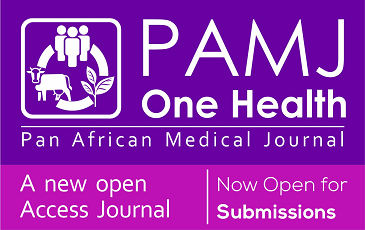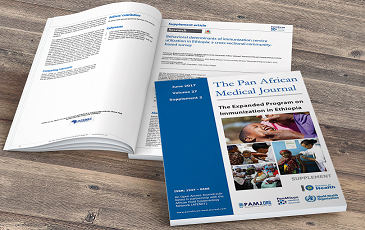Type B insulin resistance syndrome associated with gliptin-induced bullous pemphigoid: a case report in Abidjan
Tiépé Rokia Ouattara, N´guessan Michel Konan, Georges Stéphane Koffi, Fiacre Abbe, Ingrid Balmaken, Ubrich Venceslas Acko, Chantal Assy, Alain Djoman, Jacques Kacou, Yacouba Kone
Corresponding author: Tiépé Rokia Ouattara, Department of Internal Medicine, University Hospital Center of Treichville, University of Felix Houphoüet Boigny, Abidjan, Côte d´Ivoire 
Received: 28 Nov 2024 - Accepted: 10 Jan 2025 - Published: 17 Mar 2025
Domain: Metabolic bone diseases
Keywords: Type B insulin resistance, pruritus, gliptin, immunosuppressive therapy, case report
©Tiépé Rokia Ouattara et al. PAMJ Clinical Medicine (ISSN: 2707-2797). This is an Open Access article distributed under the terms of the Creative Commons Attribution International 4.0 License (https://creativecommons.org/licenses/by/4.0/), which permits unrestricted use, distribution, and reproduction in any medium, provided the original work is properly cited.
Cite this article: Tiépé Rokia Ouattara et al. Type B insulin resistance syndrome associated with gliptin-induced bullous pemphigoid: a case report in Abidjan. PAMJ Clinical Medicine. 2025;17:25. [doi: 10.11604/pamj-cm.2025.17.25.46050]
Available online at: https://www.clinical-medicine.panafrican-med-journal.com//content/article/17/25/full
Case report 
Type B insulin resistance syndrome associated with gliptin-induced bullous pemphigoid: a case report in Abidjan
Type B insulin resistance syndrome associated with gliptin-induced bullous pemphigoid: a case report in Abidjan
Tiépé Rokia Ouattara1,&, N´guessan Michel Konan1, Georges Stéphane Koffi1, Fiacre Abbe1, Ingrid Balmaken1, Ubrich Venceslas Acko2, Chantal Assy1, Alain Djoman1, Jacques Kacou1, Yacouba Kone1
&Corresponding author
Type B insulin resistance is a rare autoimmune disorder caused by antibodies that antagonize the insulin receptor, leading to difficult-to-control diabetes requiring high doses of insulin We report a case of type B insulin resistance occurring in a 52-year-old woman with gliptin-induced bullous pemphigoid. Mrs GL, a 52-year-old woman, was referred to the Internal Medicine department for the management of a hardly-controlled hyperglycemia after corticosteroids used for bullous pemphigoid. Her background revealed a history of type 2 diabetes treated with metformin and sulfonylurea, replaced by a combination of metformin-vildagliptin for 18 months. Her A1c before admission was 7.6%. Her clinical history started two months before with diffuse and intense pruritus, which led to the diagnosis of bullous pemphigoid, which required oral and corticosteroid ointment. A few days later, a major glycemic disorder occurred, requiring the use of intravenous insulin, and the corticosteroid was thus stopped. Due to the persistence of high plasmatic glucose levels, she was referred to the Internal Medicine Department. Diagnosis of type B insulin resistance syndrome was made based on poorly-controlled diabetes despite more than 4UI/kg per day of insulin added to oral medication, and a high level of anti-insulin antibodies. Immunosuppressive therapy has led to considerable changes that have been noticeable after three months of hospitalization with progressive reduction of insulin doses. Type B insulin resistance is a very rare condition that occurs in a dysimmunity context and leads to difficult-to-control diabetes. Its management is very difficult and sometimes the use of immunosuppressive therapy could be effective. Dipeptidyl peptidase-4 (DPP-4) inhibitors are known to trigger auto-immune diseases like bullous pemphigoid.
Type B insulin resistance syndrome (TBIRS) is an especially rare autoimmune disorder with unknown prevalence, caused by immunoglobulin G polyclonal antibodies that act against the insulin receptor. It leads to abnormal cellular and metabolic responses to insulin, marked by elevated levels of circulating anti-insulin receptor antibodies. Type B insulin resistance syndrome (TBIRS) results in difficult-to-control diabetes, even with high doses of insulin, requiring long duration hospitalization and usually occurred in an immunocompromised context [1]. Its exact prevalence remains unknown because there have been no population-based studies to answer the question of disease prevalence. Since this is a rare condition, few articles in the literature have been devoted to this disease, especially in sub-Saharan Africa where auto-immune diseases are usually underdiagnosed. We report a case of type B insulin resistance occurring in a 52-year-old woman with bullous pemphigoid.
Patient information: Mrs G L, a 52-year-old woman from Cote d´Ivoire, was referred in the Department of Internal Medicine for the management of a hardly-controlled hyperglycemia. A history of type 2 diabetes for 10 years was treated initially by metformin and sulfonylurea, replaced with a combination of Metformin-Vildagliptin that she has been taking for two years.
Timeline of the current episode: March 2023: she was hospitalized in the dermatology department to diagnose and manage diffuse and intense pruritus with tense blisters. The diagnosis of bullous pemphigoid was confirmed based on clinical and histologic evidence. She was thus treated with 1mg/kg daily of prednisone and also steroid ointment. Few days later, glycemic disorder occurred and corticosteroids were thus stopped. She was then transferred to the Internal Medicine Department.
Clinical findings: her symptoms on admission were a significant weight loss (32 kilograms at her admission against 68 kilograms two months before hospitalization) associated with polyuria, polydypsia and polyphagia. Due to intense scratching, hypochromic lesions and post-bullous ulceration were observed (Figure 1).
Diagnostic approach: type B insulin resistance syndrome was suspected by a poorly controlled glycemia, requiring a daily titrated dose of insulin more than 4 UI/kg combined with oral medication: Glibenclamide 10mg and Metformin 2000 milligram daily. Multiple subcutaneous injection protocol was initiated using basal Insulin and rapid-acting insulin before meals and even before snacks since she had intense polyphagia. Progressive titration was done till 346 UI daily (Figure 2). The diagnosis was then confirmed with the presence of elevated levels of anti-insulin antibodies. The screening of autoimmune conditions revealed the positivity of DNA autoantibodies and direct Coombs test while antinuclear antibodies were negative (Table 1, Table 2).
Therapeutical intervention and follow-up: immunosuppressive therapy: mofetil mycophenolate (MMF) was administered. Local and oral corticosteroids were also re-administered due to bullous pemphigoid relapse.
Follow-up and outcome intervention: considerable changes were noticeable after three months of hospitalization with the gradual correction of diabetes and weight gain. The onset of recurrent hypoglycaemia had led to progressive reduction of insulin doses to 90 Units daily and she was then discharged from hospital.
Patient perspective: Mrs GL was comfortable with the treatment given its good tolerance, the absence of side effects and weight gain. She continued glucose monitoring at home. Fasting glucose levels were in range, but postprandial glucose levels remain difficult to control due to poor diet compliance. Figure 2 summarizes the therapeutic approach and the evolution of glycaemic controls.
Informed consent: it was obtained from the patient to publish this report by the journal's patient consent policy.
Type B insulin resistance is a rare condition, generally described in middle-aged people with female predominance. It generally occurred in a dysimmunity context such as connective tissue diseases mostly systemic lupus [2]. In some cases, there are no obvious auto-immune diseases diagnosed but abnormalities like antinuclear antibodies are often detected. In our patient case, TBIRS occurred in the context of bullous pemphigoid, the most common autoimmune blistering skin disease [3]. We found no other risk factors apart from the use of Gliptins. Dipeptydil peptidase IV (DPP4) inhibitors have been identified as a major risk factor for the development of Bullous pemphigoid but the molecular mechanisms that cause the association between DPP4 inhibitors and bullous pemphigoid are currently unclear [4]. Importantly, DPP4 inhibitors-induced bullous pemphigoid does not remit fully after withdrawal of DPP4 inhibitors, suggesting that it induces and aggravates the process of bullous pemphigoid rather than a reversible side effect. In our case apparently, the expression of DPP4 is significantly affected in different autoimmune conditions. It is presumed that the DPP4 inhibitor affects the action of CD26, a costimulatory molecule involved in T cell activation [5]. Therefore a direct link between TBIRS and the use of DPP4 inhibitor might be possible, as some cases were previously identified [6].
Regarding clinical aspects, clinical features may vary whether antibodies act like agonists at the insulin receptor or antagonists when at high titre. The most common presentation is extreme insulin resistance with hyperglycemia, acanthosis nigricans, and weight loss [1-7]. In our case, acanthosis nigricans was not observed, maybe because of diffuse blisters and scratching lesions. During the remission phase, patients can experience hypoglycaemic episodes when the titre decreases, also noticed by Klubo-Gwiezdzinska et al. which allowed to reduce insulin doses [8]. However, initial presentation with hypoglycaemic phase has also been noticed in 28% of cases [1]. Some authors reported a high prevalence of hypoglycemia in Asia, with a low prevalence of acanthosis nigricans [6].
When it comes to therapeutic aspects, it includes glycemic control measures and sometimes immunosuppression. The level of insulin required to attain these goals might be very high, more than 50000UI daily in rare cases [1]. In our case insulin doses used were combined with an oral drug like metformin and sulfonylurea. Although patients with type B insulin-resistance taking antidiabetic oral drugs exhibited uncontrolled blood glucose levels and persistent insulin-resistance [8], some authors experimented the use of lower doses of Insulin combined with antidiabetic oral drugs like thiazolidinediones [9].
Regarding immunosuppressive treatment, there is no standard immunosuppression protocol. In Martin's cohort, prednisone and cyclophosphamide were the most frequently used in the first phase. Azathioprine and mycophenolate mofetil were also used during the maintenance phase in this survey [1]. The combination of plasmapheresis, intravenous immunoglobulin and glucocorticoids also showed positive effects. Some authors highlighted the effectiveness of Rituximab in hypoglycaemic form of TBIRS [10] but spontaneous remission is also possible, noticed in twenty percent of cases [1]. In our case, blood glucose levels gradually decreased over five months of treatment with the combination of insulin, antidiabetic oral drug, and immunosuppressive treatment. However, it seems difficult to decide between a spontaneous remission of the disease and the efficacy of immunosuppressive treatment.
Type B insulin resistance is a rare cause of diabetes, under-recognized in our areas. It mostly results in a hardly-controlled diabetes requiring high doses of insulin, into a dysimmunity context. The treatment is not yet standardized, the combination of an antidiabetic drug and immunosuppressive treatment generally leads to remission even though spontaneous remission is also possible. Our case is specific because it happened in an autoimmunity context, probably mediated by DPP4 inhibitors that are important risk factors of bullous pemphigoid and some other immune diseases. Due to its effects on lymphocytosis activation, inflammation and antibody production, a direct link between the use of DPP4 inhibitor and TBIRS might be possible.
The authors declare no competing interests.
Data collection: Tiépé Rokia Ouattara, Ingrid Balmaken, N´guessan Michel Konan, and Georges Stéphane Koffi. Drafting the manuscript: Tiépé Rokia Ouattara, and Ingrid Balmaken. Revising the manuscript: Tiépé Rokia Ouattara, N´guessan Michel Konan, Georges Stéphane Koffi, Fiacre Abbe, Ingrid Balmaken, Chantal Assy, Alain Djoman, Yacouba Kone, Ubrich Venceslas Acko and Jacques Kacou. All the authors have read and approved the final version of the manuscript.
Table 1: biological assessment of Mrs GL
Table 2: immunological assessment of Mrs GL
Figure 1: hypochromic lesion after intense scratching and rupture of blisters in context of bullous pemphigoid
Figure 2: evolution of glycaemic ranges and treatment of Mrs GL
- Martins LM, Fernandes VO, Carvalho MMD, Gadelha DD, Queiroz PC, Montenegro Junior RM. Type B insulin resistance syndrome: a systematic review. Arch Endocrinol Metab. 2020 Aug;64(4):337-348. PubMed | Google Scholar
- Rosenstein ED, Advani S, Reitz RE, Kramer N. The prevalence of insulin receptor antibodies in patients with systemic lupus erythematosus and related conditions. J Clin Rheumatol. 2001 Dec;7(6):371-3. PubMed | Google Scholar
- Zhang L, Chen Z, Wang L, Luo X. Bullous pemphigoid: The role of type 2 inflammation in its pathogenesis and the prospect of targeted therapy. Front Immunol. 2023 Feb 16;14:1115083. PubMed | Google Scholar
- Tasanen K, Varpuluoma O, Nishie W. Dipeptidyl Peptidase-4 Inhibitor-Associated Bullous Pemphigoid. Front Immunol. 2019 Jun 4;10:1238. PubMed | Google Scholar
- Ohnuma K, Dang NH, Morimoto C. Revisiting an old acquaintance: CD26 and its molecular mechanisms in T cell function. Trends Immunol. 2008 Jun;29(6):295-301. PubMed | Google Scholar
- Hirota Y, Suwanai H, Yamauchi T, Kadowaki T. Clinical Features of Type B Insulin Resistance in Japanese Patients: Case Report and Survey-Based Case Series Study. J Diabetes Res. 2020 Apr 4;2020:4359787. PubMed | Google Scholar
- Aubert GP, Collet-Gaudillat C, Desforges-Bullet V, Beziaud F, Vigouroux C, Lascols O et al. Syndrome d´insulinorésistance de type B: à propos d´un cas. Annales d'Endocrinologie. 2016;77(4):514. Google Scholar
- Klubo-Gwiezdzinska J, Lange M, Cochran E, Semple RK, Gewert C, Brown RJ. Combined Immunosuppressive Therapy Induces Remission in Patients With Severe Type B Insulin Resistance: A Prospective Cohort Study.Diabetes care. 2018;41(11):2353-2360. PubMed | Google Scholar
- Łebkowska A, Krentowska A, Adamska A, Lipińska D, Piasecka B, Kowal-Bielecka O et al. Type B insulin resistance syndrome associated with connective tissue disease and psoriasis. Endocrinol Diabetes Metab Case Rep. 2020 Aug 4;2020:20-0027. PubMed | Google Scholar
- Bourron O, Vigouroux C, Caron-Debarle M, Halbron M, Andreelli F, Hartemann A. Syndrome d´insulino-résistance de type B avec hypoglycémies résolutif après traitement par anticorps monoclonal anti-CD20 (Rituximab). Diabetes & Metabolism. 2014 Mar 1;40:A105. Google Scholar






